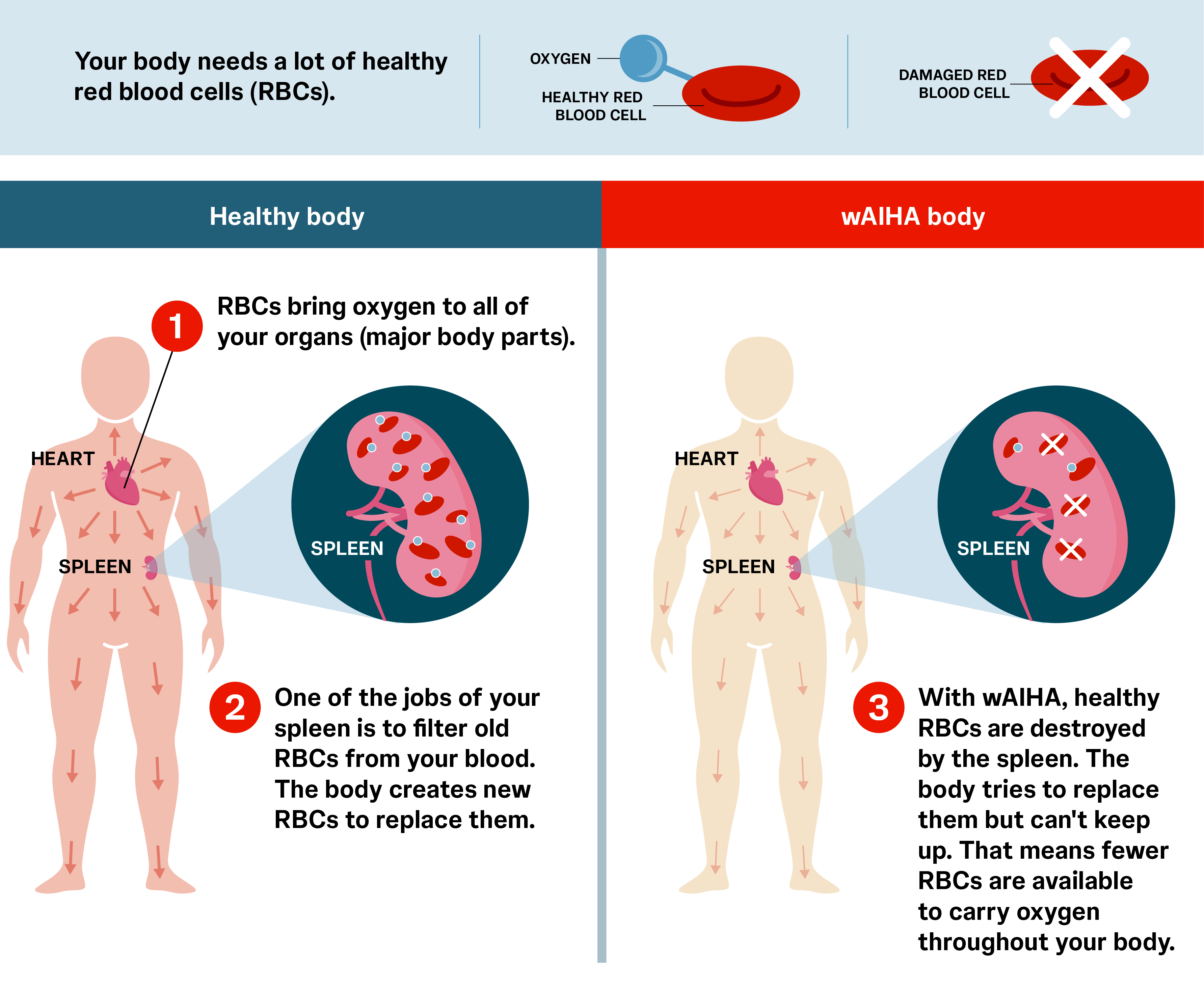What is warm autoimmune hemolytic anemia (wAIHA)?


Making sense of wAIHA
wAIHA is an autoimmune disease, which is when your immune system attacks your own body. wAIHA specifically attacks your red blood cells (RBCs).
I’ve heard of anemia. Is this the same thing?
wAIHA is different from anemia. There are actually many types of anemia, including:
Iron-deficiency anemia
Caused by lack of iron. This is a common cause of anemia
Pernicious anemia
Caused by the inability to absorb enough vitamin B12 from food
Aplastic anemia
Caused by bone marrow damage
What is the difference between wAIHA and CAD?
Warm-antibody AIHA means the autoantibody immunoglobulin G (IgG) binds to RBCs at a normal body temperature (98.6ºF).
Cold-antibody AIHA, or cold agglutinin disease/syndrome (CAD/CAS) means the autoantibody immunoglobulin M (IgM) binds to RBCs at colder temperatures (<98.6°F). It causes RBCs to clump together (this is what agglutinate means).
How to pronounce this disease
Cold agglutinin
Cold agglutinin [uh-GLU-tuh-nen] disease
Diagnosing wAIHA
What is my body doing?
Your immune system usually knows what is good and what is bad (the enemies). But sometimes the immune system becomes overactive and makes autoantibodies (IgG) that mistake their own team (the RBCs) for the enemy.
RBCs carry oxygen throughout the body.
With warm autoimmune hemolytic anemia, RBCs are attacked inside the spleen. IgG autoantibodies tag the RBCs for destruction by other immune cells.
As more RBCs are destroyed, less oxygen is able to be delivered throughout your body. As a result, your energy level drops.
Your body works hard to try and replace these RBCs but can’t keep up with the loss, which may make you feel tired or fatigued.
There are currently no FDA-approved products indicated to treat wAIHA.
Here’s another way to think about wAIHA


What are the symptoms of wAIHA?
wAIHA can show up in many ways that can start affecting your daily life. People with wAIHA have reported some or all of the following symptoms:

Fatigue (very common)

Weakness

Dizziness

Pale skin

Jaundice (yellowing of the eyes and skin)

Heart palpitations (racing, pounding, fluttering)

Dark urine

Shortness of breath
Some symptoms of wAIHA can be life-threatening. If you experience severe symptoms, seek immediate care. The following symptoms are also an emergency:
- Severe anemia, where hemoglobin levels are less than 6 g per deciliter
- Low oxygen levels
- Confusion
- Deregulation of heart rate and blood pressure
What are the blood tests performed?
Direct antibody test (DAT) or Coombs test
If your healthcare provider suspects wAIHA and tests show a destruction of RBCs (hemolysis), your healthcare provider may order a DAT test. This test is used to detect autoantibodies (IgG) that act against RBCs.

This test can confirm whether you have wAIHA.
However, there is a 5% to 10% chance the test will produce a false negative result. That does not mean a person does not have wAIHA. What it does mean is more testing will be needed, which can delay a diagnosis.
Since anemia affects RBCs, blood tests play an important role in the diagnostic process.
Other tests
Here are some other things your healthcare provider may be looking for:
- Low levels of hemoglobin and hematocrit
- High amounts of reticulocytes
- Elevated bilirubin levels
- Increased levels of LDH
- Low, or absent, levels of haptoglobin
You can read more about these tests and what they mean below.
A CBC can give you a lot of information, such as your:
- Red and white blood cell count
- Hemoglobin levels, which will be low when you have active wAIHA
- Hemoglobin is an iron-containing protein in the blood. It delivers oxygen to your body. The lower the level, the more severe the case
- Hematocrit levels, which may also be low with wAIHA
- Hematocrit is the percentage of your blood that has RBCs in it
- Reticulocyte count, which is usually high with wAIHA
- Reticulocytes are immature RBCs, which may be high when your body is trying to replace lost RBCs
Bilirubin is a yellow pigment that occurs from RBCs that have been broken down. High bilirubin can cause jaundice. Jaundice makes your eyes and skin yellow.
LDH is an enzyme inside your cells. LDH levels are high when cells are destroyed.
Haptoglobin is a protein made by your liver. It binds to free-floating hemoglobin, which is released when RBCs are destroyed. A haptoglobin test will show low levels if your body is breaking down RBCs too quickly (because haptoglobin is being used up to get rid of the hemoglobin).
This can tell your healthcare provider if your blood cells are being destroyed.
In addition, there are other conditions your healthcare provider may be looking to rule out, such as:
- Lupus
- Rheumatoid arthritis
- Ulcerative colitis
- Infections
- Vitamin B12 deficiency
What are the 2 types of wAIHA?
Primary wAIHA has an unknown cause.
Secondary wAIHA is caused by another disease or medication such as:
- Blood cancers
- Solid tumors
- Other autoimmune diseases
- Infections
- Antibiotics
- Neurologic drugs
- Anticancer drugs
- Other drugs
Speak to your healthcare provider about what may have caused your wAIHA.

How common is it?

wAIHA is rare. It happens to ~1 in 8,000 people

It can happen to anyone at any time but it’s more common in adults between the ages of 50 and 70 years
Slightly more women have wAIHA than men

People with lymphomas, leukemias, or other immune deficiencies are more likely to get wAIHA
Who will be my healthcare team?
Even with a condition like wAIHA, a PCP or general practitioner (GP) is still part of your healthcare team. You may see your PCP for other reasons, but they can also help you maintain your health when it comes to wAIHA.
Hematologists work with blood disorders.
Some specialize in other areas:
A hem/onc, or hematologist/oncologist, works with blood disorders too, but they also specialize in oncology (cancer). They also see people who don’t have cancer. This includes those with blood disorders like wAIHA. With wAIHA, seeing either a hematologist or a hem/onc is appropriate.
If your wAIHA is secondary (caused by another condition), you may see other healthcare providers who can care for your specific needs.
In addition, you may see a specialist, such as a physical therapist, a nutritionist, a therapist, or any other healthcare providers who can help you feel your best.
Some healthcare providers can do infusions in their office but some cannot. You may need to visit an infusion center to receive your wAIHA treatment. A team of healthcare professionals at these sites are trained and focused on administering your therapy.
Infusion centers see many people with many kinds of conditions. You may be treated alongside people who have other conditions.
It’s your life, your wAIHA—your way.